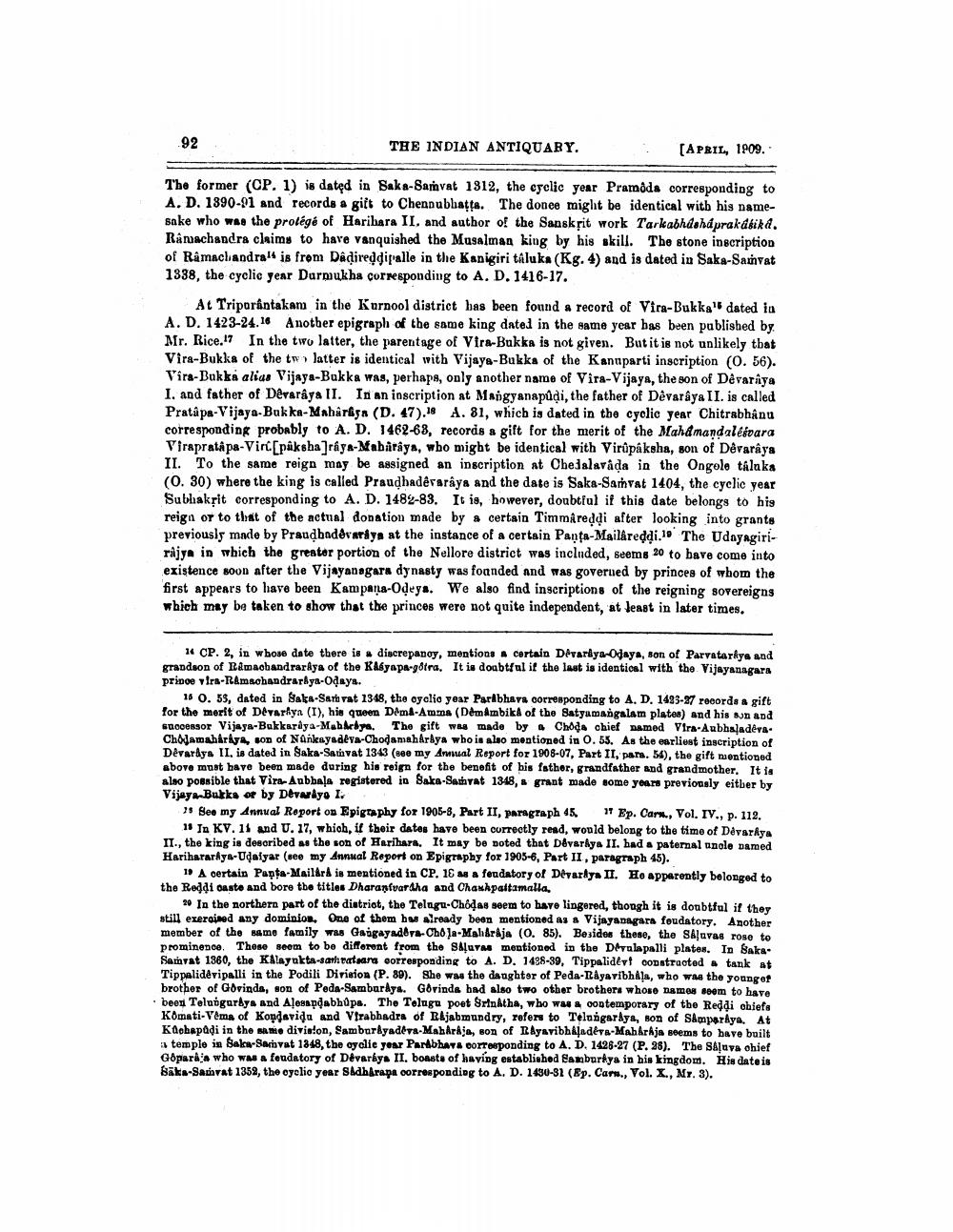________________
92
THE INDIAN ANTIQUARY.
(APRIL, 1909.
The former (CP. 1) is dated in Saka-Samvat 1312, the cyclic year Pramods corresponding to A. D. 1890-91 and records a gift to Chenpubhatta. The donee might be identical with his namesake who was the protégé of Harihara II. and author of the Sansk sit work Tarkabhdshd prakásika. Ramachandra claims to have vanquished the Musalman king by his skill. The stone inscription of Ramachandra! is from Dadireddipalle in the Kanigiri taluka (Kg. 4) and is dated in Saka-Sanyat 1338, the cyclic year Darmukha corresponding to A. D. 1416-17.
At Triporântakam in the Kurnool district has been found a record of Vira-Bukka" dated in A.D. 1423-24.16 Another epigraph of the same king dates in the same year has been pablished by Mr. Rice.17 In the two latter, the parentage of Vira-Bukka is not given. But it is not unlikely that Vira-Bukka of the tw latter is identical with Vijaya-Bukka of the Kanaparti inscription (O. 56). Vira-Bukka alias Vijaya-Bakka was, perhaps, only another name of Vira-Vijaya, the son of Devaraya I, and father of Devaraya II. In an inscription at Mangyanapudi, the father of Devaraya II. is called Pratáps-Vijaya-Bukka-Maharlia (D. 47). A. 81, which is dated in the cyclic year Chitrabhanu corresponding probably to A. D. 1462-68, records a gift for the merit of the Mahamandalesvara Virapratapa-Virt[pâksha]raya-Mabaraya, who might be identical with Virupaksha, son of Devaraya II. To the same reign may be assigned an inscription at Chedalavada in the Ongole talaka (0.30) where the king is called Praudhadêrarâya and the date is Saka-Samvat 1404, the cyclic year Subhakrit corresponding to A. D. 1482-83. It is, however, doubtful if this date belongs to his reiga or to that of the actual donation made by a certain T'immareddi after looking into grants previously made by Praudbadevaraya at the instance of a certain Panta-Mailâreddi.10 The Udayagirirajya in which the greater portion of the Nellore district was included, seems 20 to bave come into existence soon after the Vijayanagara dynasty was foanded and was goverued by princes of whom the first appears to have been Kamparla-Odeya. We also find inscriptions of the reigning sovereigns which may be taken to show that the princes were not quite independent, at least in later times.
X CP. 2, in whose date there is discrepanoy, mentions a certain Divarlyar-Odays, son of Parvatarkys and grandson of Ramachandraraya of the Kaya pa-gotra. It is doubtful if the last is identical with the Vijayanagara pripoe vira-Ramachandrarkya-Odays.
15 0. 55, dated in Sasa-Samrat 1348, the oyclio year Parbhaya corresponding to A. D. 1493-27 records a gift for the merit of Devarlyn (I), hin queen Demi-Amuns (DémámbikA of the Satyamangalam plates) and his aun and SQ.ccessor Vijaya-Bakkariya-Mabarkys. The gift was made by . Choda chief named Vira-Aubh!aderaChodamaháriye, son of Nankayadeva-Chodamah Ardya who is also mentioned in 0.55. As the earliest inscription of Devardys II, is dated in Saka-Samvat 1343 (800 my Amwual Report for 1908-07, Part II, para. 54), the gift mentioned above must have been made during his roign for the benefit of bis father, grandfather and grandmother. It is also possible that Vira-Aubbal registered in Baka-Seurat 1348, a grant made some years previously either by Vijaya-Bukks or by Devwdyo I. -
See my Annual Roport on Epigtaphy for 1905-8, Part II, paragraph 15 Ep. Carn., Vol. IV., p. 112. 15 Tn KV. 11 and U. 17, which, if their dates have been correctly read, would belong to the time of Devariya II., the king is described as the son of Harihara. It may be noted that Dêvarkys II. had a paternal uncle samed Hariharariya-Udalyar (nee my Annual Report on Epigraphy for 1905-6, Part II, paragraph 45).
11 A certain Panta-Mailárd is mentioned in CP. 16 as a feudatory of Devaraya II. He apparently belonged to the Reddi oaste and bore the titles Dharansvar dha and Chaxhpaltamalla,
20 In the northern part of the distriot, the Telugu-Chôdas seem to have lingered, though it is doubtful if they still exeroined any dominion. One of them bu already been mentioned as a Vijayanagara foudatory. Another member of the same family was Gaigayadora Chola Maharaja (0.85). Besides these, the Sauvas rose to prominence. Those seem to be different from the Skļuvas mentioned in the Devulapalli plates. In BakaSamrat 1360, the Kilayakta saratana corresponding to A. D. 1498-39, Tippalidey! constructed . tank at Tippalidèripalli in the Podili Division (P. 80). She was the daughter of Peda-Rayavibh!s, who was the younger brother of Govinda, son of Peda-Sambardys. Govinds had also two other brothers whose names seem to have been Teluógarby and Alesandabhupa. The Telugu poet Srinatha, who was contemporary of the Reddi chiefs Komati Vema of Kondavida and Virabhadra of Rajabmundry, refer to Telungardya, son of Samparkys. At Kohapadi in the same divislon, Samburyadeva.Mahirkja, son of RhyavibhAladéva-Maharaja seems to have built
temple in Saku-Sarivat 1848, the oy clic year Paribhava corresponding to A. D. 1426-27 (P. 36). The SAļuva chief Gopardi'n who was a foudatory of Devarkys II. boasts of having established Bamburkya in his kingdom. His date is Bāka-Sauvat 1352, the oyelio year Shah rapa corresponding to A. D. 1430-81 (Ep. Car., Vol. X., MY. 3).




